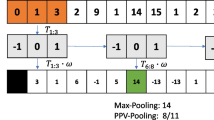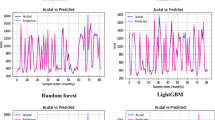Abstract
In forecasting, we often require interval forecasts instead of just a specific point forecast. To track streaming data effectively, this interval forecast should reliably cover the observed data and yet be as narrow as possible. To achieve this, we propose two methods based on regression trees: one ensemble method and one method based on a single tree. For the ensemble method, we use weighted results from the most recent models, and for the single-tree method, we retain one model until it becomes necessary to train a new model. We propose a novel method to update the interval forecast adaptively using root mean square prediction errors calculated from the latest data batch. We use wavelet-transformed data to capture long time variable information and conditional inference trees for the underlying regression tree model. Results show that both methods perform well, having good coverage without the intervals being excessively wide. When the underlying data generation mechanism changes, their performance is initially affected but can recover relatively quickly as time proceeds. The method based on a single tree performs the best in computational (CPU) time compared to the ensemble method. When compared to ARIMA and GARCH modelling, our methods achieve better or similar coverage and width but require considerably less CPU time.













Similar content being viewed by others
References
Appice A, Ceci M (2006) Mining tolerance regions with model trees. In: International symposium on methodologies for intelligent systems. Springer, pp 560–569
Baena-García M, del Campo-Ávila J, Fidalgo R, Bifet A, Gavaldà R, Morales-Bueno R (2006) Early drift detection method. In: Fourth international workshop on knowledge discovery from data streams
Bifet A, Gavaldà R (2007) Learning from time-changing data with adaptive windowing. In: Proceedings of the 2007 SIAM international conference on data mining. SIAM, pp 443–448
Bifet A, Gavaldà R (2009) Adaptive learning from evolving data streams. In: International symposium on intelligent data analysis. Springer, pp 249–260
Bifet A, Holmes G, Pfahringer B, Kirkby R, Gavaldà R (2009) New ensemble methods for evolving data streams. In: Proceedings of the 15th ACM SIGKDD international conference on knowledge discovery and aata mining. ACM, pp 139–148
Bifet A, Holmes G, Kirkby R, Pfahringer B (2010) MOA: massive online analysis. J Mach Learn Res 11:1601–1604
Domingos P, Hulten G (2000) Mining high-speed data streams. In: Proceedings of the sixth ACM SIGKDD international conference on knowledge discovery and data mining. ACM, pp 71–80
Duarte J, Gama J, Bifet A (2016) Adaptive model rules from high-speed data streams. ACM Trans Knowl Discov Data (TKDD) 10(3):30
Gama J, Medas P, Castillo G, Rodrigues P (2004) Learning with drift detection. In: Brazilian symposium on artificial intelligence. Springer, pp 286–295
Ghalanos A (2014) rugarch: Univariate GARCH models. R package version 1.3-5
Gholipour A, Hosseini MJ, Beigy H (2013) An adaptive regression tree for non-stationary data streams. In: Proceedings of the 28th annual ACM symposium on applied computing. ACM, pp 815–817
Hothorn T, Zeileis A (2015) partykit: A modular toolkit for recursive partytioning in R. J Mach Learn Res 16:3905–3909. http://jmlr.org/papers/v16/hothorn15a.html
Hothorn T, Hornik K, Van De Wiel MA, Zeileis A (2006a) A lego system for conditional inference. Am Stat 60(3):257–263
Hothorn T, Hornik K, Zeileis A (2006b) Unbiased recursive partitioning: a conditional inference framework. J Comput Graph Stat 15(3):651–674
Hyndman RJ (2017) forecast: Forecasting functions for time series and linear models. http://pkg.robjhyndman.com/forecast. R package version 8.2
Hyndman RJ, Khandakar Y (2008) Automatic time series forecasting: the forecast package for R. J Stat Softw 26(3):1–22. http://www.jstatsoft.org/article/view/v027i03
Ikonomovska E, Gama J, Džeroski S (2011) Learning model trees from evolving data streams. Data Min Knowl Disc 23(1):128–168
Ikonomovska E, Gama J, Džeroski S (2015) Online tree-based ensembles and option trees for regression on evolving data streams. Neurocomputing 150:458–470
Jin R, Agrawal G (2003) Efficient decision tree construction on streaming data. In: Proceedings of the ninth ACM SIGKDD international conference on knowledge discovery and data mining, KDD ’03, pp 571–576, New York, NY, USA, 2003. ACM. ISBN 1-58113-737-0. https://doi.org/10.1145/956750.956821
Khosravi A, Nahavandi S, Creighton D (2011) Prediction interval construction and optimization for adaptive neurofuzzy inference systems. IEEE Trans Fuzzy Syst 19(5):983–988
Krawczyk B, Cano A (2018) Online ensemble learning with abstaining classifiers for drifting and noisy data streams. Appl Soft Comput 68:677–692. https://doi.org/10.1016/j.asoc.2017.12.008
Milan Z, Taylor C, Armstrong D, Davies P, Roberts S, Rupnik B, Suddle A (2016) Does preoperative beta-blocker use influence intraoperative hemodynamic profile and post-operative course of liver transplantation? Transpl Proc 48(1):111–115
Nishida K, Yamauchi K (2007) Detecting concept drift using statistical testing. In: International conference on discovery science. Springer, pp 264–269
Percival DB, Walden AT (2000) Wavelet methods for time series analysis, vol 4. Cambridge University Press, Cambridge
Pfahringer B, Holmes G, Kirkby R (2007) New options for Hoeffding trees. In: Australasian joint conference on artificial intelligence. Springer, pp 90–99
Quan H, Srinivasan D, Khosravi A (2014) Short-term load and wind power forecasting using neural network-based prediction intervals. IEEE Trans Neural Netw Learn Syst 25(2):303–315
R Core Team (2014) R: a language and environment for statistical computing. R Foundation for Statistical Computing, Vienna, Austria. http://www.R-project.org/
Ross GJ, Adams NM, Tasoulis DK, Hand DJ (2012) Exponentially weighted moving average charts for detecting concept drift. Pattern Recognit Lett 33(2):191–198
Sethi TS, Kantardzic M (2017) On the reliable detection of concept drift from streaming unlabeled data. Expert Syst Appl 82:77–99
Shrestha DL, Solomatine DP (2006) Machine learning approaches for estimation of prediction interval for the model output. Neural Netw 19(2):225–235
Sobhani P, Beigy H (2011) New drift detection method for data streams. Adapt Intell Syst 6943:88–97
Whitcher B (2013) waveslim: Basic wavelet routines for one-, two- and three-dimensional signal processing. http://CRAN.R-project.org/package=waveslim. R package version 1.7.3
Wuertz D, Setz T, Chalabi Y, Boudt C, Chausse P, Miklovac M (2019) fGarch: Rmetrics—autoregressive conditional heteroskedastic modelling. https://CRAN.R-project.org/package=fGarch. R package version 3042.83.1
Yoshida S-I, Hatano K, Takimoto E, Takeda M (2011) Adaptive online prediction using weighted windows. IEICE Trans 94–D:1917–1923
Zhao X, Barber S, Taylor CC, Milan Z (2018) Classification tree methods for panel data using wavelet-transformed time series. Comput Stat Data Anal 127:204–216
Acknowledgements
Xin Zhao is grateful for the financial support of the China Scholarship Council (CSC) (Grant No. 201506270135) during this research, which was completed during her Ph.D. studies at the University of Leeds.
Author information
Authors and Affiliations
Corresponding author
Additional information
Publisher's Note
Springer Nature remains neutral with regard to jurisdictional claims in published maps and institutional affiliations.
Electronic supplementary material
Below is the link to the electronic supplementary material.
Rights and permissions
About this article
Cite this article
Zhao, X., Barber, S., Taylor, C.C. et al. Interval forecasts based on regression trees for streaming data. Adv Data Anal Classif 15, 5–36 (2021). https://doi.org/10.1007/s11634-019-00382-7
Received:
Revised:
Accepted:
Published:
Issue Date:
DOI: https://doi.org/10.1007/s11634-019-00382-7




